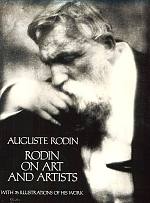|
1. The primacy of Nature
 Rodin´s concept of sculpture was a revolt against the prevailing academic practice of his time. At the end of his life, after having reached international recognition, the Master explained his understanding of Art to his friend Paul Gsell, who edited and published these conversations in 1911. Rodin´s concept of sculpture was a revolt against the prevailing academic practice of his time. At the end of his life, after having reached international recognition, the Master explained his understanding of Art to his friend Paul Gsell, who edited and published these conversations in 1911.
In these dialogues, Rodin condemns any Art that is sterile or artificial, and stresses the primary importance of Nature. One
evening when the night had begun to darken the atelier with heavy shadows,
I had a talk with the master on his method.
"What astonishes me in you," said I, "is that you work
quite differently from your confrères. I know many of them and have seen
them at work. They make the model mount upon a pedestal called the throne,
and they tell him to take such or such a pose. Generally they bend and
stretch his arms and legs to suit them, they bow his head or stretch his
body exactly as though he were a clay figure. Then they set to work. You,
on the contrary, wait till your models take an interesting attitude, and
then you reproduce it. So much so that it is you who seem to be at their
orders rather than they at yours."
Rodin, who was engaged in wrapping his figurines in damp clothes,
answered quietly:
"I am not at their orders, but at those of Nature! My confrères
doubtless have their reason for working as you have said. But in thus
doing violence to nature and treating human beings like puppets, they run
the risk of producing lifeless and artificial work.
"As for me, seeker after truth and student of life as I am, I shall
take care not to follow their example. I take from life the movements I
observe, but it is not I who impose them.
"Even when a subject which I am working on compels me to ask a model
for a certain fixed pose, I indicate it to him, but carewfully avoid
touching him to place him in the position, for I will reproduce only what
reality spontaneously offers to me.
"I obey Nature in everything, and I never pretend to command her. My
only ambition is to be servilely faithful to her."  Paul Gsell, Rodin on Art and Artistst, Dover Publications, New York, p.
10-11
Paul Gsell, Rodin on Art and Artistst, Dover Publications, New York, p.
10-11
Nature, in Rodin´s eyes, not only is the sum of all dead and animated matter, a realm not
ruled by human will. For the artist, it is a source of inspiration, of beauty and grace, but
also of hidden forces, that do not cease to shape man’s fate, even in the age of
industrialism. Nature not only means landscape, the uncultivated rest beyond the city’s
borders. Nature makes up the core of all living beings, it is the root of human existence
and emotions. It is the pulsing energy that drives us and manifests itself despite all
social rules and constraints.


|